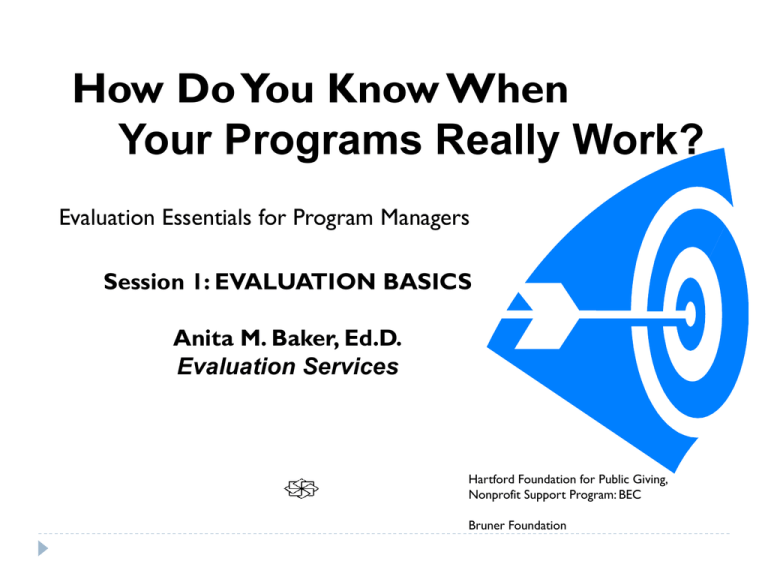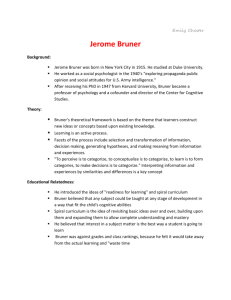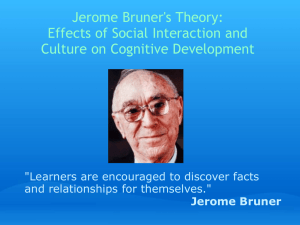Anchoring Essentials - Effectiveness Initiatives in Evaluative Thinking
advertisement

How Do You Know When Your Programs Really Work? Evaluation Essentials for Program Managers Session 1: EVALUATION BASICS Anita M. Baker, Ed.D. Evaluation Services Hartford Foundation for Public Giving, Nonprofit Support Program: BEC Bruner Foundation These materials are for the benefit of any 501c3 organization. They MAY be used in whole or in part provided that credit is given to the Bruner Foundation. They may NOT be sold or redistributed in whole or part for a profit. Copyright © by the Bruner Foundation 2012 * Please see supplementary materials for a sample agenda, activities and handouts Bruner Foundation Rochester, New York How to Use the Bruner Foundation Evaluation Essentials for Program Managers Powerpoint Slides The Evaluation Essentials for Program Managers slides were developed as part of a Bruner Foundation special project, by evaluation trainer Anita Baker – Evaluation Services, and jointly sponsored by the Hartford Foundation for Public Giving. They were tested initially with a single organization in Rochester, NY (Lifespan) as part of the Evaluation Support Project 2010. The materials were revised and re-tested with three nonprofit organizations as part of the Anchoring Evaluation project in 2011-12. The slides, intended for use in organizations that have already participated in comprehensive evaluation training, include key basic information about evaluation planning, data collection and analysis in three separate presentations. Organization officials or evaluation professionals working with nonprofit organization managers are encouraged to review the slides, modify order and add/remove content according to training needs. (Please note that the first session begins with a presentation of “results” as a framework to help trainees see the overall relevance of evaluative capacity, i.e., what they are working toward. There is an ancillary file with multiple slides of “results” which can be substituted depending on trainee organization program focus.) Additional Materials To supplement these slides there are sample agendas, supporting materials for activities, and other handouts. There are “placeholder” slides with just a picture of the target with an arrow in the bullseye that signify places where activities can be undertaken. Be sure to move or eliminate these depending on the planned agenda.Other more detailed versions of the Evaluation Essentials materials area also available in Participatory Evaluation Essentials: An Updated Guide for Nonprofit Organizations and Their Evaluation Partners and the accompanying 6-session slide presentation. These materials are also available on the Bruner Foundation and Evaluation Services websites free of charge. Whether you are an organization leader or an evaluation professional working to assist nonprofit organization staff, we hope that the materials provided here will support your efforts. When you have finished using the Evaluation Essentials for Program Managers series have trainees take our survey. https://www.surveymonkey.com/s/EvalAnchoringSurvey Bruner Foundation Rochester, New York 2 What if you saw results like these? Alger Middle School and Matching School F, Percentage of Students with 16+ Days Absent, 2005-2008 45.0% Alger Middle School Matching School F 40.0% 34.3% Percentage of Students 35.0% 29.5% 30.0% 25.0% 28.6% 24.1% 18.9% 20.0% 16.2% 15.0% 10.0% 5.0% 0.0% 2005-2006 i 2006-2007 2007-2008 Or results like these? More than 90% of case managers at all sites but location C indicated they had fully adopted the Program model (PM). Two-thirds or more of clients at all sites but location C reported improved quality of life. SITE ii % of clients reporting improved quality of life since PM initiated. A 69% B 73% C 40% D 71% E 66% Or these? 100% 80% No Growth, unplanned exit 60% No Growth, Planned Exit Growth + unplanned exit Growth + planned exit 40% 20% 0% 18-24, no kids iii 18-24, with kids 25+, no kids 25+, with kids What if you saw results like these? RESULTS Desired Outcome iv 2009 2010 * 65% of Clients show slowed or prevented disease progression at 6 and 12 months 83% 87% * 75% of clients are fully engaged in HIV primary medical care 96% 96% * 80% of clients show progress in 2 or more areas of service plan 90% 94% * 50% of clients with mental health issues show improvement in mental health function by 6 months 97% 97% * 75% of clients enrolled in SA treatment decrease use of drugs/alcohol after accessing services 93% 92% * 90% of clients show improved or maintained oral health at 6 and 12 months 92% 94% Logical Considerations for Planning 1. 2. 3. 4. Think about the results you want. Decide what strategies will help you achieve those results? Think about what inputs you need to conduct the desired strategies. Specify outcomes, identify indicators and targets.** DECIDE IN ADVANCE, HOW GOOD IS GOOD ENOUGH 5. 6. 1 Document how services are delivered. Evaluate actual results (outcomes). Outcomes and Indicators Changes in behavior, skills, knowledge, attitudes, condition or status. Specific, measurable characteristics or changes that represent achievement of an outcome. 2 Indicator: Reminders 3 Many outcomes have more than one indicator Identify the set of indicators that accurately signal achievement of an outcome (get stakeholder input) Targets Specify the amount or level of outcome attainment expected, hoped for or required. Targets can be set. . . . 4 Relative to external standards (when available) Past performance/similar programs Professional hunches Target: Reminders 5 Should be specified in advance. Requires buy in. Carefully word targets so they are not over or under-ambitious, make sense, and are in sync with time frames. If target indicates change in magnitude – be sure to specify initial levels and what is positive. Outcome, Indicator, Target - EXAMPLE Outcome Indicators At least 500 students will participate each month. Participants will be actively involved in afterschool activities Students will attend 70% or more of all available sessions. At least half of participants will participate in 100 or more hours per semester. 6 Outcome, Indicator, Target - EXAMPLE Outcome Participants will learn important skills Indicators 75% of campers’ parents will report their child learned something new at camp. Two-thirds of campers enrolled in swimming will demonstrate competency in 3 basic strokes. Most campers (85%) will demonstrate mastery of all performance dance moves. 7 Outcome, indicator, target - EXAMPLE Outcome Indicators 65% of clients show slowed or prevented disease progression at 6 and 12 months Sustained CD4 counts within 50 cells 50% of clients with MH issues show improvement at 3 months, by 6 months or at program end. Maintaining or decreasing mental health distress symptoms from baseline to follow-up using SDS 8 Viral loads <5000 Indicator Examples with Time References Outcomes Indicators Initial: Teens are knowledgeable of prenatal nutrition and health guidelines Program participants are able to identify food items that are good sources of major dietary requirements Participants are within proper ranges for prenatal weight gain Intermediate: Teens follow proper nutrition and health guidelines Participants abstain from smoking Participants take prenatal vitamins Longer Term: Teens deliver healthy babies 9 Newborns weigh at least 5.5 pounds and score 7 or above on the APGAR scale. Outcomes, indicators and targets activity How do you know when your programs really work? . . . . EVALUATION Program Evaluation Thoughtful, systematic collection and analysis of information about activities, characteristics, and outcomes of programs, for use by specific people, to reduce uncertainties, inform decisions. 10 How do you know when your programs really work? . . . . EVALUATION Program Evaluation Thoughtful, systematic collection and analysis of information 10 How do you know when your programs really work? . . . . EVALUATION Program Evaluation Thoughtful, systematic collection and analysis of information about activities, characteristics, and outcomes of programs, 10 How do you know when your programs really work? . . . . EVALUATION Program Evaluation Thoughtful, systematic collection and analysis of information about activities, characteristics, and outcomes of programs, for use by specific people, to reduce uncertainties, inform decisions. 10 What do you need to do to conduct Evaluation? Specify key questions Specify an approach (develop an evaluation design) Apply evaluation logic Collect and analyze data 11 Summarize and share findings Key Questions Focus and drive the evaluation. Should be carefully specified and agreed upon in advance of other evaluation work. Generally represent a critical subset of information that is desired. 12 Evaluation Question Criteria It is possible to obtain data to address the questions. There is more than one possible “answer” to the question. The information to address the questions is wanted and needed. It is known how resulting information will be used internally (and externally). The questions are aimed at changeable aspects of activity. 13 Participants identify questions using criteria How do you know when your programs really work? . . . . EVALUATION Program Evaluation Thoughtful, systematic collection and analysis of information about activities, characteristics, and outcomes of programs, for use by specific people, to reduce uncertainties, inform decisions. Types, Focuses and Timing of Evaluation TYPE FOCUS TIMING Monitoring Compliance with terms of a grant, or program design Period of the grant or program duration Formative Implementation While program is operating Short/Mid-Term Outcomes While program is operating, at certain key junctures Long-term outcomes As or after the program ends Summative 14 Evaluators Characteristics of Effective Evaluators Basic knowledge of substantive area being evaluated Knowledge about and experience with program evaluation Field is un-regulated First graduate level training programs in evaluation recent Good references from sources you trust Personal style and approach fit (MOST IMPORTANT) 15 Evaluation Strategy Clarification All Evaluations Are: Partly social Partly political Partly technical Both qualitative and quantitative data can be collected and used and both are valuable. There are multiple ways to address most evaluation needs. Different evaluation needs call for different designs, data and data collection strategies. 16 Evaluation Purposes Evaluations are conducted to: 17 Render judgment Inform decision-making Facilitate improvements Generate knowledge Specify at earliest stages of evaluation planning. Obtain input from stakeholders. Who are Evaluation Stakeholders, and Why Do They Matter? Decision-makers Information-seekers Those directly involved with the evaluation subject Most programs/strategies have multiple stakeholders. Organization managers, clients and/or their caregivers, program staff, program funders, partner organizations 18 Stakeholders have diverse, often competing interests related to programs and evaluation. Certain stakeholders are the primary intended users of evaluation.











